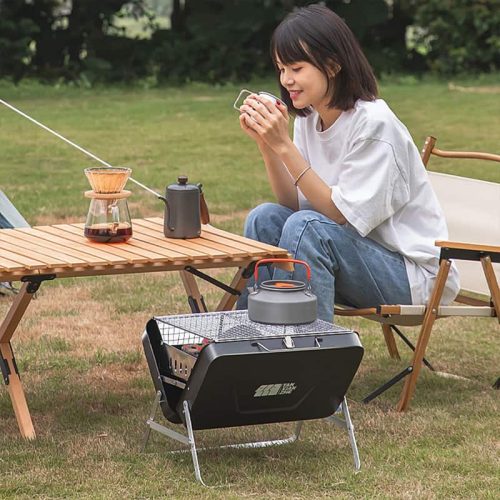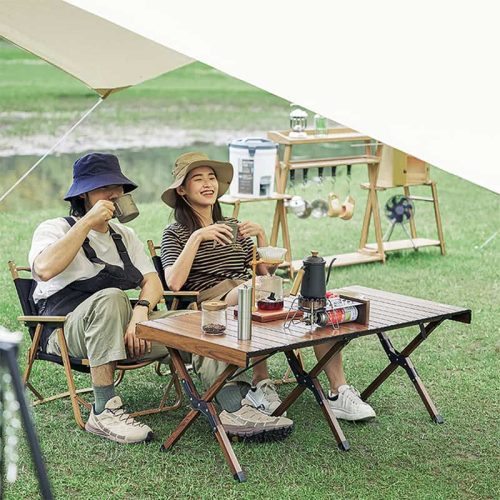Table of Contents

1. Advantages of camping table and chair combination
The camping table and chair combination offers several advantages that enhance your outdoor experience. Here are some key benefits:
- Convenience: The combination of a camping table and chairs provides convenience by offering a dedicated space for dining, relaxing, and socializing. It eliminates the need to sit on the ground or use unstable surfaces, making your camping experience more comfortable and enjoyable.
- Comfortable Seating: Camping chairs are designed with comfort in mind. They often feature padded seats and backrests, providing excellent support for your back and promoting proper posture. This allows you to relax and enjoy your time at the campsite without discomfort.
- Versatility: A camping table and chair set offers versatility in its usage. The table provides a stable surface for various activities, such as cooking, playing games, or setting up a workspace. The chairs can be used not only at the table but also around the campfire, for stargazing, or simply for lounging and soaking up nature.
- Easy Setup and Portability: Camping tables and chairs are designed to be lightweight and easy to set up. They often feature a foldable design that allows for quick assembly and disassembly. This portability makes them convenient for transporting to and from the campsite, as well as for storage when not in use.
- Socialization and Bonding: Having a camping table and chair set encourages socialization and bonding with fellow campers. It provides a designated area where you can gather for meals, conversations, and shared activities. This fosters a sense of community and creates memorable experiences around the campsite.
- Organization: A camping table often includes storage options such as shelves, compartments, or hanging hooks. These features allow you to keep your camping essentials, cooking utensils, and personal belongings organized and easily accessible. It helps in maintaining a tidy campsite and saves you from searching for items when you need them.
- Durability and Longevity: Camping tables and chairs are typically made from durable materials that can withstand outdoor conditions. They are designed to resist moisture, UV exposure, and general wear and tear. Investing in a quality set ensures that your camping furniture will last for multiple trips, providing reliable performance and value over time.
Overall, the combination of a camping table and chair set enhances your camping experience by offering convenience, comfort, versatility, and socialization opportunities. It’s a valuable addition to your camping gear, providing a designated space for relaxation, dining, and creating lasting memories in the great outdoors.
2. How to choose the material of camping tables and chairs
When choosing the material for camping tables and chairs, there are several factors to consider, including durability, weight, portability, comfort, and weather resistance. Here are some common materials used for camping furniture, along with their characteristics:
- Aluminum: Aluminum is a popular choice for camping furniture due to its lightweight nature and corrosion resistance. It is durable and can withstand outdoor conditions well. Aluminum tables and chairs are easy to carry and transport, making them suitable for camping trips.
- Steel: Steel is heavier than aluminum but offers greater strength and stability. Steel camping furniture tends to be more durable and long-lasting. However, it can be bulkier and harder to transport compared to aluminum.
- Wood: Wooden camping furniture provides a classic and natural aesthetic. It can be sturdy and comfortable, but it is generally heavier and less portable than aluminum or steel options. Wood requires more maintenance, such as sealing or varnishing, to protect it from moisture and other outdoor elements.
- Plastic: Plastic is lightweight, affordable, and easy to clean. It is resistant to moisture and does not require much maintenance. However, plastic furniture may not be as durable as metal or wood, and it can be prone to cracking or fading when exposed to prolonged sunlight.
- Nylon or Polyester: Some camping chairs and compact tables are made with fabric seats and tabletops supported by lightweight frames. These materials are typically used for portable, collapsible camping furniture. They are lightweight, easy to pack, and often come with carrying bags. However, they may not offer the same level of sturdiness as metal or wooden furniture.
Consider your specific needs and preferences when selecting the material for camping tables and chairs. Think about the intended use, the frequency of use, the weight you are comfortable carrying, and the weather conditions you may encounter during your camping trips.

3. Dimensions of camping tables and chairs
Camping tables and chairs come in various dimensions to accommodate different needs and preferences. While specific dimensions can vary between different models and brands, here are some common ranges:
Camping Tables:
- Length: The length of camping tables can range from around 2 feet (60 cm) to 6 feet (180 cm) or more. Longer tables provide ample space for dining or setting up cooking equipment.
- Width: The width of camping tables typically ranges from 1 foot (30 cm) to 3 feet (90 cm) or more. Wider tables offer more surface area for placing items or seating multiple people.
- Height: The height of camping tables varies, but a common range is around 2 feet (60 cm) to 3.5 feet (105 cm). Adjustable height tables can be set at different levels to accommodate various seating arrangements or preferences.
Camping Chairs:
- Seat Height: The seat height of camping chairs generally falls between 12 inches (30 cm) and 18 inches (45 cm). Lower seat heights provide a relaxed seating position, while higher seat heights are more suitable for dining or use at camping tables.
- Seat Width: Camping chair seat widths typically range from 16 inches (40 cm) to 20 inches (50 cm) or more. Wider seats offer more comfort and accommodate users of different body sizes.
- Backrest Height: The height of the backrest on camping chairs can vary. Common ranges are between 20 inches (50 cm) and 30 inches (75 cm). Taller backrests provide better support for the upper back and neck.
- Weight Capacity: Camping chairs have weight capacity ratings that indicate the maximum weight they can safely support. The weight capacities vary but often range from 200 pounds (90 kg) to 400 pounds (180 kg) or more, depending on the chair’s design and materials.
It’s important to note that these dimensions are approximate and can vary depending on the specific model and brand of camping tables and chairs. It’s recommended to refer to the manufacturer’s specifications for precise dimensions when considering a particular product.
4. Cleaning and maintenance points for camping tables and chairs
Here are some quick cleaning and maintenance tips for camping tables and chairs:
- Clean with mild soap and water after each use.
- Allow them to air dry completely before storing.
- Store in a clean, dry area.
- Check for damage and address it promptly.
- Maintain metal frames by removing rust and applying protective coatings.
- Follow fabric care instructions for chairs with fabric seating.
- Tighten any loose fasteners or connections.
- Adhere to weight capacity guidelines.
Following these tips will help keep your camping tables and chairs clean, functional, and in good condition.

